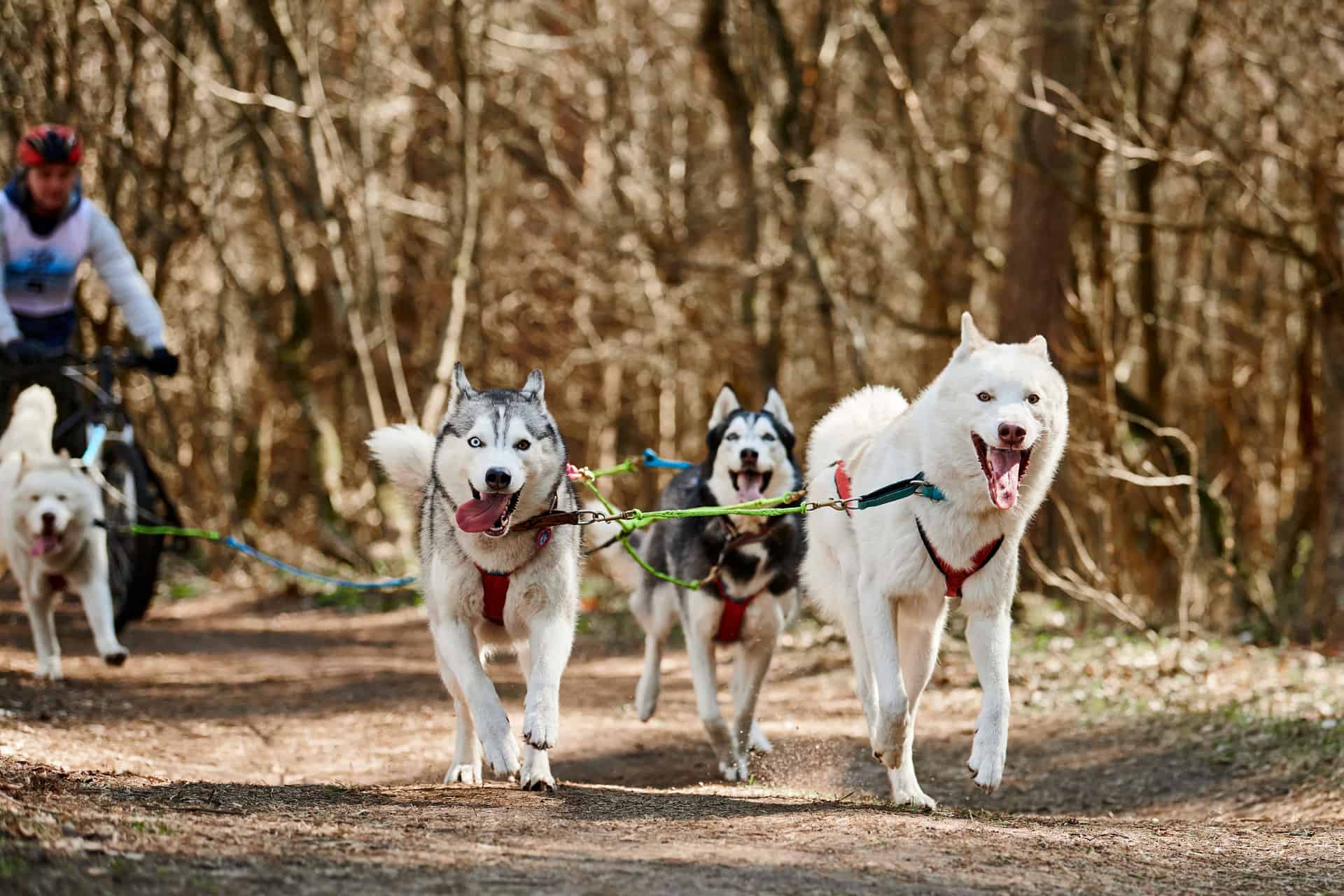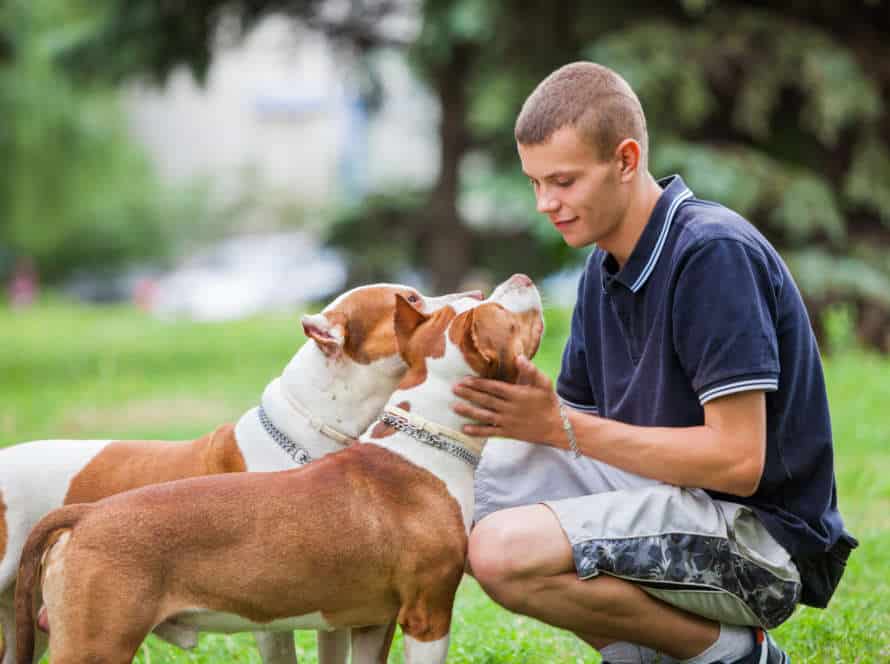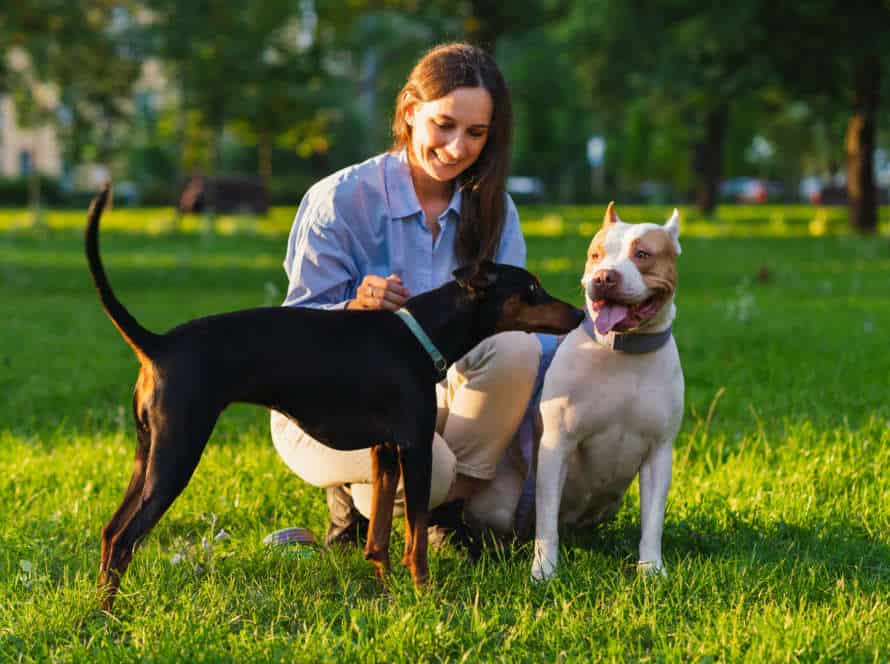Fostering Healthy Relationships Among Your Dogs
A peaceful and harmonious home is dependent on having a healthy relationship between your pups. Here are some helpful tips to make this happen:
- Spend individual time with each dog daily. This will deepen their bond and stop them from becoming jealous.
- Train together. Doing this encourages teamwork and lessens aggressive behavior. Plus, it gives them the chance to learn from one another!
- Watch playtime. Keep an eye on them to be sure it stays friendly. Interrupt any aggressive act as soon as it occurs and then direct their attention to something else.
- Provide separate resources. Give each pup their own food and water bowls, beds, and toys to avoid arguments.
Be mindful that fostering good relationships amongst your doggos is an ongoing process. Patience, consistency, and positive reinforcement are key!
Understanding Canine Behavior
Dogs are social creatures! They need other canines for companionship. To help your pooches have healthy relationships, you must learn their behavior. Plus, you need to know the cues they give when interacting.
Here’s an overview of canine behavior and tips to help your furry friends stay happy and connected:
The importance of socialization
Socialization is key for canine behavior. It promotes healthy relationships and well-being of dogs. It helps them:
- Learn social skills like communication, play, and body language.
- Avoid issues like aggression and anxiety.
- Adapt to different environments, people, and animals.
- Increase confidence when facing unknown situations.
It’s important to start socializing dogs early. For extra help, enroll your pup in socialization classes. This way they can have positive interactions with other dogs, and you can socialize them, too.
Recognizing body language signals
Recognizing body language signals is critical for understanding canine behavior. Dogs show a variety of emotions through their body language. This helps you understand their mood and keep healthy relationships.
Here are the most common body language signals to watch out for when with your dogs:
- Tail Wagging: It can show happiness, excitement, fear or aggression.
- Ear Placement: Ears laid-back = fear. Perked-up ears = alertness and curiosity.
- Eye Contact: Direct eye contact can mean affection or aggression, depending on the dog.
- Growling: Fear or aggression.
- Pro Tip: Look at your dog’s entire body language and context to get an accurate understanding of their behavior and mood.
The role of dominance and submission
Dominance and submission are key in canine behavior. They can greatly influence the quality of the relationships between dogs in a house.
Dominance is when one dog has more power than the others. Submission is when dogs show respect to another dog’s status.
It’s vital to recognize dominance and submission signs. These can be growling, snapping, or changes in body posture. If these get aggressive, intervention may be necessary.
By understanding and managing dominance and submission, a safe and harmonious environment can be created for all the furry friends.
Building Positive Relationships
Diverse doggies – of all ages, sizes, and characters – can make a house a home! If you’re introducing a pup to your pad, it’s important to form positive relationships and build an atmosphere of trust and acceptance. Getting along is key to their mental and physical health.
Here are some tips to help your four-legged family members bond:
Properly introducing dogs to each other
Introducing canines correctly is vital for making strong relationships and promoting good relations between your pets. Here are some steps to take for a successful introduction:
- Pick a neutral spot: Take the dogs to a place neither knows, like a park or your friend’s garden, instead of bringing the new one straight home.
- Restrain the pooches: Keep them leashed or in different cages to avoid any aggression from either.
- Let them sniff: Allow the furballs to get acquainted with each other from a distance by sniffing.
- Praise proper conduct: Reward your four-legged friends with treats when they show positive behaviour like sniffing and wagging tails.
- Be patient: Make the introduction short and slowly build up the time they spend together. Have patience; not all introductions take the same amount of effort. Pro Tip: Always watch over them when they are together until they develop a healthy bond.
Creating a structured routine
Creating routine is very important to have good relationships between your dogs. It can give them a sense of security and set limits to reduce fighting and anger. Here are some tips:
- Set meal times the same every day.
- Schedule daily playtime to help them bond and use energy.
- Create different sleeping areas for each dog to avoid claiming territory.
- Make sure every dog has individual attention every day.
Consistency is important for creating a good routine. Keep the same schedule as much as you can to help them feel secure.
Encouraging cooperative behavior
Fostering cooperative behavior between your canines is a must for having good relationships and creating a pleasant home ambiance. Here are some tricks to encourage good cooperation:
- Provide each pup with its own food and water bowl to stay away from possessiveness.
- Train every pup one by one to steer clear of rivalry, then introduce them little by little.
- Give each dog its own area and bed to avoid conflict over territory.
- Keep playtime sessions watched, and make sure each pup gets the same amount of attention.
- Reward good behavior like sharing toys, beds, or consideration, to support cooperative behavior.
By fostering cooperative behavior, your canines will learn how to work together, strengthening their bonds, and forming a more tranquil home environment.
Managing Problem Behaviors
Fostering healthy relationships between multiple dogs is key. Identify and address any problem behaviors that could harm harmony. Excessive barking, aggression and dominance? Don’t worry! Provide consistent, positive reinforcement.
Here’s what to do to address these issues and foster better relationships between your pups:
Dealing with aggressive behavior
Dealing with aggressive behavior in dogs needs patience, consistency, and understanding of the causes. Here are some tips for managing problem behaviors and promoting healthy relationships:
- Spot triggers: Observe your doggies and figure out what sets off their aggressive behavior. It could be anything from meeting strangers to territory issues.
- Control the environment: Alter your dogs’ environment to avoid their aggressive behavior. This may mean avoiding select people, modifying the spot of their food bowls or sleeping area, or keeping them on a leash when in public.
- Be constant: Use consistent and clear words with your pooches to encourage good behavior and discourage aggressive behavior.
- Get professional help: If their aggressive behavior continues, ask for help from an experienced dog trainer or behaviorist.
Remember, managing problem behaviors in your pups takes time and effort. With patience and consistency, you can create a peaceful home atmosphere and foster healthy relationships among your doggies.
Addressing separation anxiety
Dogs with separation anxiety can show destructive behavior, vocalization, and house-soiling. Here are tips to address it and have healthy relationships with them:
- Gradually desensitize your dog to being alone. Start by leaving home for short periods, then increase the time.
- Create a safe and secure space when you leave. Give your pet an enclosed area or comfortable crate.
- Interactive toys like Kongs or puzzle feeders can keep them busy and provide mental stimulation in your absence.
- Avoid reinforcing anxious behavior, such as excessive greetings. Ignore them when you arrive and leave, and wait until they calm down before greeting them.
- Ensure they get enough exercise and attention when you’re home. Consider obedience training to curb unwanted behaviors.
- Monitor progress to manage separation anxiety. If it does not improve or gets worse, contact an animal behaviorist for help.
Stopping possessive behavior
Possessive behavior in dogs can be managed, even stopped. To do this, use these effective techniques:
- Show your dog that you are the pack leader – set boundaries and stay consistent.
- Teach your dog basic commands like ‘sit’, ‘stay’ and ‘come’. This will help them understand expectations and respond appropriately.
- Desensitize your dog to triggers that make them possessive. Use positive reinforcement and gradually introduce objects that trigger possessive behavior. Reward them for staying calm.
- Avoid situations that cause possessive behavior.
- Finally, if your efforts don’t work, consult a professional trainer or behaviorist.
Remember, success requires consistency, patience and positive reinforcement.
Pro tip: Always supervise interactions between dogs to prevent possessive behavior.
Training Techniques
Key to good pup relationships? Training! Consistent and proper training is essential to create a positive connection between doggies. This is especially important if you have a new pet joining a home with an existing pooch. Training will help the dogs communicate and build understanding.
Let’s explore some training techniques to foster a healthy relationship between your dogs.
Using positive reinforcement
Positive reinforcement is great for building strong relationships with your dogs. They love getting praised and rewarded. Here are some tips:
- Use treats – give them straight away when they do the right thing.
- Verbal praise – say “good dog” or “well done“.
- Playtime – your pup loves it and it reinforces good behaviour.
- Consistency – make sure you’re consistent with rewarding them.
This way, you can use positive reinforcement to train your doggies and create a great connection.
Fostering trust and teamwork
Fostering trust and teamwork with your pups is key for a peaceful home. Here are some training tips to help:
- Have individual sessions with each pup, to build a strong bond and trust.
- Have group training to help them work as a team.
- Use treats, praise and rewards to reward good behavior.
- Be consistent with your training and rules, so they know what’s expected.
- Give them different people, places, and experiences, so they feel confident.
Pro Tip: Supervise them during training for safety and to prevent misbehavior.
Using obedience training for better relationships
Obedience training can promote a better relationship with your pup and good relationships between all your dogs. Here are some tips you can use:
- Lead with positivity, provide treats and verbal praise when they do something right.
- Teach basic commands like ‘sit’, ‘stay’, ‘come’ and practice regularly.
- Be consistent, patient and reward them when they do something correctly.
- Use clicker training or luring to teach new skills and commands.
By following these techniques, you can help your dog have a more enriched life and build better relationships with all your dogs.
Common Issues and Solutions
Possessing more than one pooch in the home can cause a range of troubles. From quarrels over territory to aggression.
It’s critical to look after each pup’s individual requirements but also to observe the links between them and ensure they are healthy. In this section, we’ll discuss the common problems that can arise and the top solutions to deal with them.
Introducing a new dog into the household
Introducing a new pup to an existing household can be tricky. But, with the right preparation and training, you can help foster a loving relationship between your canines. Here are some common issues and solutions:
- Territorial aggression: Keep the dogs apart initially, and introduce them bit by bit in an unfamiliar area outside the home. Give each dog their own space, bed, and toys to cut down on competition and stop territorial issues.
- Jealousy and rivalry: Monitor their behaviour and instantly tackle any bad interactions. Praise and reward them for good behaviour.
- Health matters: Make sure your pets are up-to-date with vaccinations and get them checked out by a vet before meeting. This is especially crucial if one of the dogs has a history of aggression or illness.
- Resource guarding: Provide enough resources, like food, beds, and toys for each dog. This will reduce competition and resource guarding.
By following these tips, you can make sure the transition is smooth and help your dogs form a strong bond.
Managing conflicts between dogs
Canines can sometimes behave aggressively or territorially towards each other, which can cause conflicts. It is essential to understand these difficulties and their solutions, to promote healthy relationships between your dogs.
Here are some tips to manage conflicts between them:
- Give each pup their own space and try to avoid envy or rivalry over resources, like food and toys.
- Introduce new pooches gradually in a controlled setting, using positive reinforcement techniques to support good behavior.
- Keep a lookout for signs of tension, such as growling, hackles raised, and stiff posture. Intervene before conflicts become serious.
- If needed, get professional help from a dog trainer or behaviorist to address underlying issues or aggression.
Using these tips will help create a harmonious atmosphere for all your furry pals!
Addressing jealousy and attention-seeking behavior.
Jealousy and craving for attention are common issues with multiple dogs in a household. Solutions exist to help create harmonious relationships!
To address jealousy:
- Spend individual time with each pup and give them affection.
- Train each dog alone – this boosts their confidence and reduces jealousy.
- Supply each pooch with the same access to resources e.g. food, water, toys, beds.
To address attention-seeking behaviour:
- Ignore their whining or jumping up – reward calm and polite behaviour.
- Teach them a command to go lie in their designated area when they seek attention.
- Exercise and give mental stimulation daily – to avoid boredom and attention-seeking.
Pro tip: Be the pack leader. Set consistent rules and boundaries for all the dogs in the home to decrease tension and competition.
Frequently Asked Questions
Q: How can I introduce a new dog to my current dog?
A: It’s important to introduce them on neutral territory, such as a park, and provide plenty of space and supervision. Gradually increase their time together and reward good behavior.
Q: How do I prevent my dogs from fighting?
A: Ensure each dog has their own resources, such as food bowls and toys. Avoid triggers, such as high-value treats or toys. Monitor their body language and intervene early if they show signs of aggression.
Q: How can I encourage my dogs to get along?
A: Provide positive reinforcement for good behavior, such as sharing toys and lying together peacefully. Encourage joint activities, such as walks or training sessions.
Q: Is it okay for my dogs to sleep together?
A: Yes, if they are comfortable with each other and it does not lead to conflicts. It’s important to provide each dog with their own designated sleeping space as well.
Q: What should I do if my dogs are overly aggressive towards each other?
A: Seek the help of a professional dog trainer or behaviorist to identify the underlying causes and develop a plan to address the aggression.
Q: How can I prevent jealousy between my dogs?
A: Ensure each dog receives individual attention and feel valued. Avoid favoritism or overcompensating for a perceived slight.







